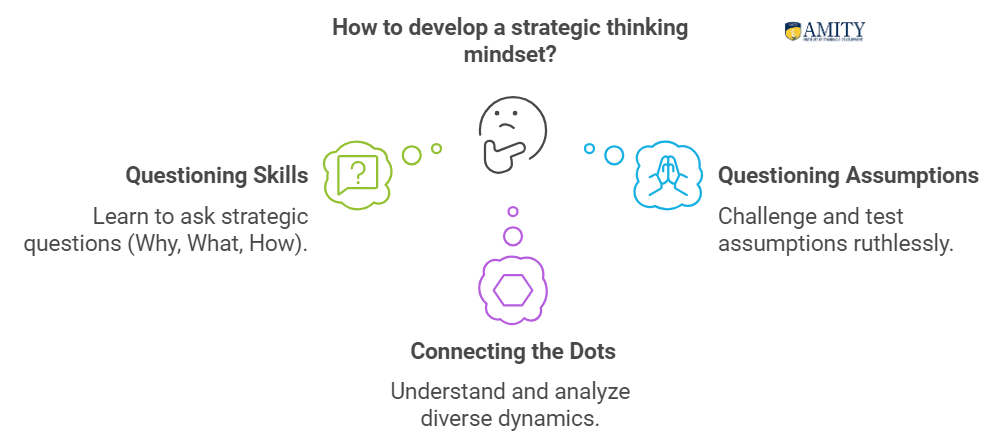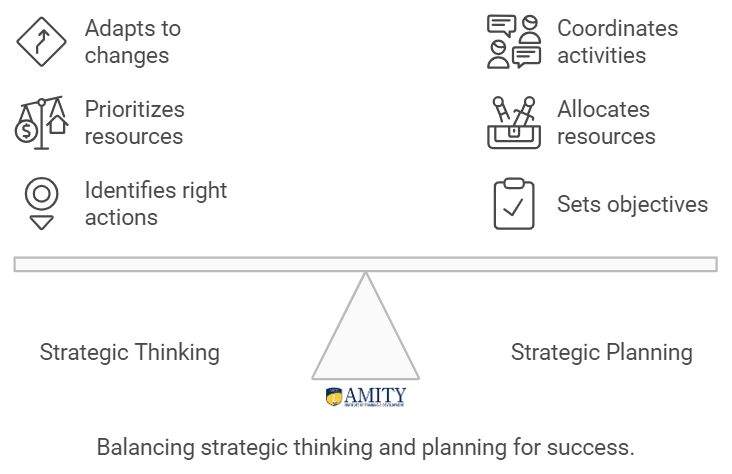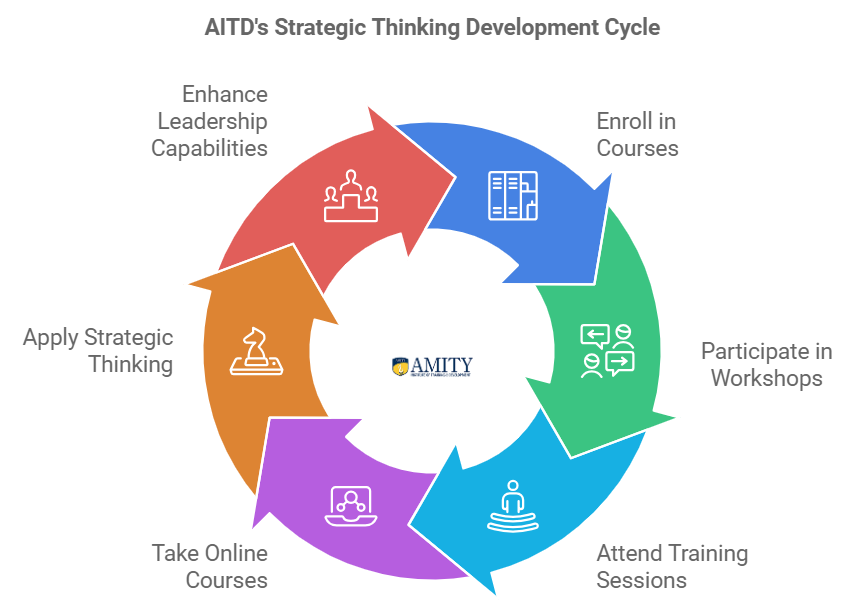Tech-Driven Solutions

Developing strategic thinking among the leaders who want to lead their ships in the business environment of today is very essential. This includes critical situation analysis, defining long-term goals amidst complexity, and informed decisions made in keeping with organizational goals.
For instance, a leader can be developed with strategic competencies, including the analysis and optimization of resources through various training programs and workshops. In fact, as statistics show, organizations that have strong strategic thinkers are 30% more probable to outperform their competitors in achieving long-term success.
Here, investing in strategic thinking courses and fostering a culture of innovation will ensure that teams equipped to handle future challenges present themselves in a well-groomed leader. Adopt strategic practices and be ready for full expression in your leadership and results for sustainable growth.
The blog will discuss strategic thinking meaning, strategic thinking skills in leadership, and how to work effectively toward these skills.
Understanding Strategic Thinking: What Does It Mean?
It refers to the thought process through which complex situations are evaluated, all feasible outcomes considered, and strategies devised that are congruent with long-term objectives. It involves various aspects:
- Analysis: Critical analysis of data and trends.
- Vision: Creating a clear mental picture of goals.
- Flexibility: Strategically changing means of meeting changing circumstances.
The best leaders in strategic implication can be able to predict which problems are likely to arise and take steps to prevent them. This is a characteristic attribute in the leadership of teams through transition processes and aligning them with organization objectives.

Strategic Thinking Meaning: A Key Competency for Leaders
In the definition of strategic thinking meaning, it is understood in more general terms that it has the aspect of looking away from the short-term scope of work and instead on the objectives for the larger organization. Strategic effectiveness involves asking questions such as:
- Are we doing the right thing?
- What are the potential consequences for our options?
- How can I leverage my strengths to pay back opportunities?
- Help develop organizational culture toward strategic planning by encouraging creativity in solving problems and also collaboration in making decisions?
Now, through its personal shopper program, Walmart uses AI to suggest the best possible substitute for an out-of-stock item.
“A thinking process applied by an individual in the context of achieving a goal.”
The Shift from Strategic Planning to Strategic Thinking
Strategic planning was a C-Suite executive and management zone subject. You did not have to know more in your early years, and I was happily oblivious just worrying about my bit of work and focusing there. But did that encourage me to speak up and share my ideas or my learnings on a topic of organizational importance or understand how to join the dots and make my contribution matter in the big picture, or did I even see and comprehend the big picture? – Well, you know the answer.
It became more and more evident that the best teams and organizations move away from strategic planning in board rooms to practicing strategic management across all levels.
DO YOU KNOW? According to a 2022 survey by McKinsey & Company, almost 90% of executives ranked increasing the strategic mindset within their organizations as one of the top priorities, but just a quarter of them felt their teams were adequately equipped with the relevant skills.
In strategic planning, leaders gather data and decide on the path the organization will take to achieve their goals. With strategic culture, employees at all levels and in all functions continually scan for new ways to contribute to the organization’s success. They apply those insights as they carry out organizational priorities and provide input to the overall strategy. In this way, strategic change is part of everyone’s job – whatever their role or level of responsibility.

(Source: Medium)
The attributes of strategic methods are thus important for superior business performance and the maintenance of sustainable competitive advantages.
Why Strategic Management is Essential for Everyone
Well, what I have learnt in my experience of working across various roles and teams is that thinking strategically is becoming especially pertinent now with flat and dispersed teams and matrix structures.
The merits of enabling and empowering every person in the team to know and work towards the common long-term goal are far-reaching than just the individual’s short-term horse staring approach leading to reactions to present challenges.
The better leaders/managers involve their teams for deriving their team vision, as well in the process ideation, identifying opportunities by encouraging questions, assumptions and learning from the larger ecosystem.
Awareness leads to better and more informed decisions and even if it requires re-alignment of goals, which is often the case, it yields better and closer targets as just one of the outcomes. There are several intangible benefits like learning and leaning to agility, entrepreneurship mindset to name a couple more.
But what if it is not my natural style? Michael Porter said- “Strategic Thinking rarely occurs spontaneously”. Strategic value creation like most practices can be learnt, trained on, and improvised. Simple things like thinking deeply about where you want to head, encouraging dissent in teams, being open to tangential thinking, freeing teams to speak up are just some practices you may be already doing.

DO YOU KNOW? According to a Harvard Business Review study, organizations with leaders who can think strategically outperform their rivals in terms of revenue growth and profitability by 23%.
Developing a Strategic Mindset: Essential Practices for Leaders

In strategic management, a mindset for strategic framework is one of the most prominent qualities leaders need to acquire to move within a very complex business environment. As stated above, Henry Mintzberg did find that the associated thinking process is genuinely different and special with some distinct traits. The following are some good practices that could be applied at both individual and team levels to enhance strategic risk management.
1. Working on Questioning Skills
The easiest and most obvious way to get better at strategy is simply by asking more strategic questions. This is a great way to test out your planning skills and make those strategic decisions that you just might employ during the rest of your working life.
The Harvard Business School publication suggests that a strategic question may be about any difficulty, chance, or uncertainty you are up against in your current life at work or at home. For example, these could be about starting a new business or product, defeating competition for innovation in your organization. For example, one can have a better sense of the problem by asking why, what, and how?
- Why? – Why is an altitudinal question. It gives the perspective about a situation from a higher ground … above 10000 feet! It helps one to have an eagle-eye view of the situation and can be used effectively to have a detached view of things – Why are we in this current situation? Why is it important? Why do we need to think about this?
- What? – What is the realistic or actual question. It gives the perspective about a situation or a problem – “as it is” or gives an “as is “view of things. – What does the situation imply for us? What does the future look like?
- How? – How is the action question? Whenever we frame a situation as to how, it’s where we are thinking about the idea – How can we solve this? What could we change to do things otherwise?
2. Questioning your assumptions
Once you land on nebulous things around which an organization may well help shepherd itself to its goals, question your assumptions and test the hypothesis ruthlessly since otherwise you simply miss out on other possibility.To develop this skill, get in the habit of questioning yourself any time you are about to make an assertion. Should you consider a different perspective? Is there another possibility you may have overlooked?
Ask yourself – Am I missing something? There will still be unknowns or factors which were not counted in. Adapt and adjust and be ready to re-align. If you have prepared for this with the above aspects, then ultimately you would be better placed to do so.
3. Working on your ability to connect the dots
This might be a more obvious one, but do you remember that game as a kid where what seemed like randomly arranged dots on the page were then joined together in such a precise manner and suddenly an image appeared? Connect-the-dots may be a simple pastime from your youth, but it is also a metaphor for one of the most powerful capabilities of all successful leaders: strategic mindset.
Strategists should be uncomfortable with vague concepts like “soft synergy.” They should not accept generalized theories of economic behavior, and they should try to understand the underlying specific dynamics relevant to their business in an unbiased way. This ability to connect the dots and let the picture backed by hard facts emerge is a great asset in developing strategic sustainability. The ability to connect the dots can be chiseled by being aware of yourself and the environment you are in – informed about the economy, politics, laws, human behavior etc. More awareness about varied dimensions shall lead one to connect dots well.
Real-Life Strategic Thinking Examples from Successful Companies
There should be real-life examples regarding strategic digital transformation . A Big corporation like Apple and Amazon has survived because they understand how to adapt and innovate strategically. For instance:
- Apple: Apple has remained the industry leader in consumer electronics through an orientation of continuous emphasis on user experience as well as integration of hardware and software.
- Amazon: Amazon, diversified from cloud computing into logistics, has developed a number of streams that improve firm resistance to market shocks.

DO YOU KNOW? Amazon’s web service is its cloud computing business segment, which has accounted for more than $62 billion revenue by 2021.
Others, however, are cautions to avoid. Companies such as Kodak and Motorola are more feared than emulated. Kodak first came up with the first digital camera but failed to shift from its film business to digital photography, filing into bankruptcy. Motorola lost its lead through failure to innovate in smartphones, losing its share in markets it once dominated.

The research paper “Exploring the Importance of Strategic Thinking to Strategic Planning in the Strategic Management Process” puts forth the critical significance of strategic innovation in improving strategic planning and effectiveness. The study posits that the incorporation of strategic practices into organizational planning results in more flexible and creative strategies and enhances decision-making and organizational performance.
How Can AITD Enhance Your Strategic Thinking Skills for Leadership Success?
The establishment of strategic thinking in leadership is quite significant in the competitive business environment of today. It involves an understanding of the concept of strategic mindset, a realization of its essence, and development of the necessary skills in strategic project management. But how do organizations nurture this mind in their leaders? This is when Amity Institute of Training and Development (AITD) comes into play.
Role of AITD in Strategic Performance Improvement

AITD offers a good combination of training that enables leaders to develop their strategic capabilities. This includes the following:
1. Strategic Thinking Courses
This series of courses is believed to equip the leader with the necessary ‘tools’ to be able to engage in proper strategic planning and actual decision-making.
2. Workshops and Training Sessions
The workshops of AITD facilitate maximum interaction with topics through training sessions in which a participant can experience practical activities that strengthen the grounds for strategically structured strategic thinking framework.
3. Online courses
For all those who want flexibility, AITD is offering strategic insights courses, which cover many aspects of strategic planning and delivery.
The Way Ahead with AITD: Building Strategic Leadership Competency in Teams
Developing strategic planning is highly needed for leaders who wish to navigate the complex business environment of today. Investing in a training scheme and embracing new approaches in driving an organization toward long-term success enables enhanced leadership capabilities. Explore the offerings at AITD to begin your journey toward becoming a strategic leader today!







